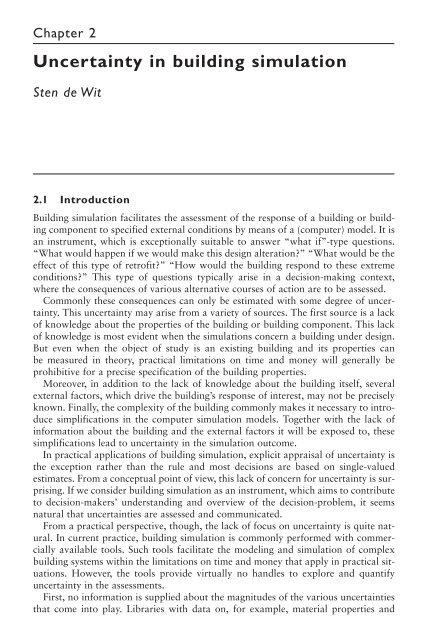Advanced Building Simulation
Advanced Building Simulation
Advanced Building Simulation
You also want an ePaper? Increase the reach of your titles
YUMPU automatically turns print PDFs into web optimized ePapers that Google loves.
Chapter 2<br />
Uncertainty in building simulation<br />
Sten de Wit<br />
2.1 Introduction<br />
<strong>Building</strong> simulation facilitates the assessment of the response of a building or building<br />
component to specified external conditions by means of a (computer) model. It is<br />
an instrument, which is exceptionally suitable to answer “what if”-type questions.<br />
“What would happen if we would make this design alteration?” “What would be the<br />
effect of this type of retrofit?” “How would the building respond to these extreme<br />
conditions?” This type of questions typically arise in a decision-making context,<br />
where the consequences of various alternative courses of action are to be assessed.<br />
Commonly these consequences can only be estimated with some degree of uncertainty.<br />
This uncertainty may arise from a variety of sources. The first source is a lack<br />
of knowledge about the properties of the building or building component. This lack<br />
of knowledge is most evident when the simulations concern a building under design.<br />
But even when the object of study is an existing building and its properties can<br />
be measured in theory, practical limitations on time and money will generally be<br />
prohibitive for a precise specification of the building properties.<br />
Moreover, in addition to the lack of knowledge about the building itself, several<br />
external factors, which drive the building’s response of interest, may not be precisely<br />
known. Finally, the complexity of the building commonly makes it necessary to introduce<br />
simplifications in the computer simulation models. Together with the lack of<br />
information about the building and the external factors it will be exposed to, these<br />
simplifications lead to uncertainty in the simulation outcome.<br />
In practical applications of building simulation, explicit appraisal of uncertainty is<br />
the exception rather than the rule and most decisions are based on single-valued<br />
estimates. From a conceptual point of view, this lack of concern for uncertainty is surprising.<br />
If we consider building simulation as an instrument, which aims to contribute<br />
to decision-makers’ understanding and overview of the decision-problem, it seems<br />
natural that uncertainties are assessed and communicated.<br />
From a practical perspective, though, the lack of focus on uncertainty is quite natural.<br />
In current practice, building simulation is commonly performed with commercially<br />
available tools. Such tools facilitate the modeling and simulation of complex<br />
building systems within the limitations on time and money that apply in practical situations.<br />
However, the tools provide virtually no handles to explore and quantify<br />
uncertainty in the assessments.<br />
First, no information is supplied about the magnitudes of the various uncertainties<br />
that come into play. Libraries with data on, for example, material properties and

















